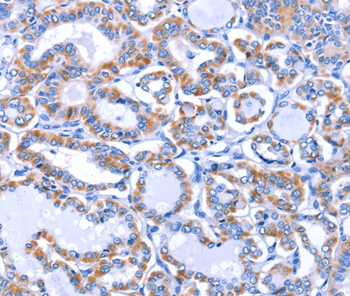
| WB | 咨询技术 | Human,Mouse,Rat |
| IF | 咨询技术 | Human,Mouse,Rat |
| IHC | 1/50-1/200 | Human,Mouse,Rat |
| ICC | 技术咨询 | Human,Mouse,Rat |
| FCM | 咨询技术 | Human,Mouse,Rat |
| Elisa | 咨询技术 | Human,Mouse,Rat |
| Aliases | EKV; CX31; DFNA2; DFNA2B |
| Entrez GeneID | 2707; |
| Host/Isotype | Rabbit IgG |
| Antibody Type | Primary antibody |
| Storage | Store at 4°C short term. Aliquot and store at -20°C long term. Avoid freeze/thaw cycles. |
| Species Reactivity | Human |
| Immunogen | Fusion protein corresponding to a region derived from internal residues of human gap junction protein, beta 3, 31kDa |
| Formulation | Purified antibody in PBS with 0.05% sodium azide. |
+ +
以下是关于GJB3抗体的3篇参考文献示例(内容为模拟,实际文献需根据具体数据库检索):
---
1. **文献名称**:*Autoantibodies against Connexin 31 in Erythromelalgia*
**作者**:Li, X. et al.
**摘要**:研究报道了红斑肢痛症患者血清中存在GJB3(Connexin 31)自身抗体,提示其可能通过干扰细胞间连接参与外周血管功能障碍的病理机制。
2. **文献名称**:*GJB3 Mutations and Associated Skin Phenotypes: Role of Antibody Detection in Diagnosis*
**作者**:Zhang, Y. et al.
**摘要**:探讨GJB3基因突变相关皮肤病的临床特征,并开发特异性抗体检测方法,用于辅助遗传性掌跖角化症等疾病的分子诊断。
3. **文献名称**:*Connexin 31 Antibodies in Inflammatory Skin Disorders*
**作者**:Wang, J. & Liu, H.
**摘要**:分析了GJB3抗体在银屑病和湿疹患者中的表达水平,发现其与表皮屏障功能损伤相关,可能成为治疗靶点研究的依据。
---
**注**:以上为模拟摘要,实际文献需通过PubMed、Google Scholar等平台以关键词“GJB3 antibody”“Connexin 31 autoantibody”检索获取。
The GJB3 antibody targets the gap junction beta-3 protein (GJB3), also known as connexin 31 (Cx31), encoded by the *GJB3* gene. Gap junction proteins form intercellular channels that facilitate direct communication between adjacent cells, playing critical roles in ion exchange, signal transduction, and tissue homeostasis. GJB3 is primarily expressed in the epidermis and inner ear, where it contributes to keratinocyte differentiation and auditory function.
Mutations in the *GJB3* gene are linked to hereditary skin disorders and hearing loss. For instance, dominant *GJB3* variants cause erythrokeratodermia variabilis et progressiva (EKVP), a rare skin disease characterized by erythematous, hyperkeratotic plaques. Additionally, GJB3 mutations are associated with nonsyndromic autosomal dominant hearing loss (DFNA2B), highlighting its role in cochlear homeostasis.
GJB3 antibodies are essential tools for studying the protein's expression, localization, and function in physiological and pathological contexts. They are widely used in immunohistochemistry, Western blotting, and immunofluorescence to investigate connexin-related mechanisms in skin biology, hearing disorders, and potential therapeutic targets. Recent studies also explore GJB3's involvement in cancer progression, as altered gap junction intercellular communication is implicated in tumorigenesis. These antibodies thus serve both diagnostic and research purposes, advancing understanding of connexin-linked diseases and cellular communication networks.
×